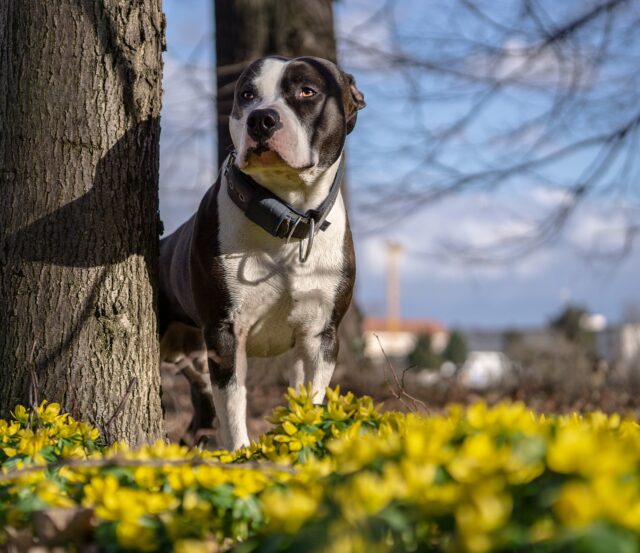When we think about our beloved American Staffordshire Terriers, it’s hard to imagine these energetic, playful pups ever slowing down. Known for their strength, loyalty, and sometimes goofy antics, American Staffordshire Terriers (often affectionately referred to as AmStaffs) seem like they might stay young forever. But, like all living creatures, they eventually reach their golden years. Determining when an AmStaff officially becomes a senior dog can be tricky. This fun and humorous guide will explore the signs and stages of aging in these charming canines so you’ll know when to start celebrating their senior status and pampering them even more than usual.

1. The Puppy Stage: Where It All Begins
Every American Staffordshire Terrier starts life as an adorable, wiggly bundle of energy. During the puppy stage, which lasts until about 1 year old, these little dynamos are all about exploring, chewing on anything they can get their paws on, and generally keeping their humans on their toes. At this stage, they’re far from senior status, but they are laying the foundation for the loyal and loving dogs they’ll become.
2. The Teen Years: 1 to 2 Years Old
From 1 to 2 years old, AmStaffs are in their teenage years. Just like human teenagers, they can be a handful. Expect a lot of energy, rebellious behavior, and the occasional dramatic sigh when you ask them to do something. They’re still growing and developing, both physically and mentally, and have boundless enthusiasm. Old age? They’re not even thinking about it!
3. The Prime Time: 3 to 6 Years Old
American Staffordshire Terriers hit their prime between the ages of 3 and 6. They’re strong, confident, and full of vitality. This is the stage where they’re likely physically and mentally at their peak. They’re more settled than in their younger years but still active and playful. They have the energy to play fetch for hours and the stamina to keep up with your morning jogs. Old age is still a distant thought.
4. The Mature Years: 7 to 9 Years Old
Around the age of 7, you might start noticing your AmStaff showing signs of maturity. They’re still active and playful but might prefer a nap in the sun to a marathon fetch session. At this stage, they might be considered middle-aged. Some gray hairs might start appearing around their muzzle, and they might not be as spry as they used to be. However, they’re still far from old, just a bit more distinguished.
5. The Senior Stage: 10 Years and Up
By the time your American Staffordshire Terrier hits 10 years old, they’re officially considered a senior dog. But don’t let that fool you; many AmStaffs maintain their playful nature well into their senior years. They might move a bit slower and take longer naps, but they still have that spark of mischief in their eyes. They’re more content with gentle walks and cozy cuddles rather than intense play. Their wisdom and experience make them even more endearing.
6. Signs of Aging in AmStaffs
As your American Staffordshire Terrier ages, you might notice some common signs of aging. These can include graying fur, especially around the muzzle, decreased energy levels, and perhaps a touch of arthritis, making those once effortless leaps onto the couch a bit more challenging. You might also see changes in their hearing and vision. Despite these signs, senior AmStaffs still have a lot of love to give and enjoy their golden years with dignity.
7. Caring for Your Senior AmStaff
Caring for an older American Staffordshire Terrier involves adjusting to ensure their comfort and health. Regular vet check-ups become even more crucial, and you might need to modify their diet to support their aging bodies. Gentle exercise, mental stimulation, and plenty of love are key to keeping your senior AmStaff happy. Soft bedding, joint supplements, and perhaps a ramp to help them get on the bed or couch can make a big difference in their quality of life.
An American Staffordshire Terrier reaches old age around 10 years old, but each dog is unique, and some might show signs of aging earlier or later. Regardless of when your AmStaff becomes a senior, they will always be the loving, loyal companion you’ve come to cherish. Embrace their golden years with joy, providing them with the care and attention they need to enjoy their twilight years in comfort and happiness. After all, whether they’re bounding around like a puppy or lounging like a seasoned sage, your AmStaff’s heart remains full of love for you.
Frequently Asked Questions Someone Might Have About Their Aging American Staffordshire Terrier

1. At what age is an American Staffordshire Terrier considered a senior dog?
American Staffordshire Terriers are generally considered senior dogs, around 7 to 8 years old. This can vary somewhat based on the individual dog’s health, genetics, and lifestyle. As they approach this age range, you might start noticing signs of aging, such as graying fur around the muzzle, a decrease in energy levels, and perhaps some stiffness or slower movements. While they might not be as spry as they were in their younger years, senior AmStaffs still have plenty of love and affection to give. Regular vet check-ups, a balanced diet, and appropriate exercise are key to ensuring their health and happiness as they age.
2. What are common signs of aging in American Staffordshire Terriers?
Common signs of aging in American Staffordshire Terriers include graying fur, especially around the muzzle, reduced energy levels, and increased stiffness or difficulty in movement, which could be due to arthritis. You may also notice changes in their hearing and vision, such as cloudiness in the eyes or difficulty responding to sounds. Additionally, senior AmStaffs might have changes in their weight—either gaining or losing weight more easily than before. They might also experience dental issues or changes in appetite. Regular veterinary care can help manage these signs and ensure your dog’s comfort as they age.
3. How can I help my senior American Staffordshire Terrier stay active?
To help your senior American Staffordshire Terrier stay active, focus on gentle, low-impact exercises on their joints. Short, frequent walks are beneficial, as they provide physical activity without overexerting them. Swimming is another excellent option, as it offers a full-body workout without putting stress on the joints. Engage them in gentle play sessions with their favorite toys, and consider incorporating mental stimulation activities like puzzle toys to keep their mind sharp. Regular vet check-ups are important to tailor an exercise plan that suits your dog’s needs and abilities as they age.
4. What dietary changes should I consider for my aging AmStaff?
As your American Staffordshire Terrier ages, you might need to adjust their diet to meet their changing nutritional needs. Senior dogs often require fewer calories due to decreased activity levels, so a lower-calorie diet can help prevent weight gain. Look for high-quality dog food formulated for senior dogs, which typically includes more fiber for digestive health and joint supplements like glucosamine and chondroitin. Ensure they have access to fresh water and monitor their food intake to prevent overeating. Consult your veterinarian to create a diet plan that meets your senior dog’s health needs.
5. How often should I take my senior AmStaff to the vet?
Senior American Staffordshire Terriers should visit the vet at least twice a year for regular check-ups. These visits allow the veterinarian to monitor your dog’s health, detect any age-related issues early, and adjust their care plan as needed. During these check-ups, your vet may perform blood tests and dental exams and assess their weight and mobility. More frequent visits may be necessary if your dog has chronic health conditions or shows signs of illness. Regular veterinary care is crucial in managing your senior dog’s health and ensuring they remain comfortable and happy in their golden years.
6. What are some common health issues in senior American Staffordshire Terriers?
Common health issues in senior American Staffordshire Terriers include arthritis, which causes joint pain and stiffness, making it difficult for them to move around. Heart disease, particularly dilated cardiomyopathy, is also prevalent and can lead to heart failure if not managed properly. Cancer, including mast cell tumors and lymphomas, is another serious concern in older AmStaffs. Additionally, they may suffer from hypothyroidism, causing weight gain, lethargy, and skin problems. Regular veterinary check-ups, a healthy diet, and appropriate exercise can help manage these conditions and improve your dog’s quality of life as they age.
7. How can I make my home more comfortable for my aging AmStaff?
To make your home more comfortable for your aging American Staffordshire Terrier, consider providing orthopedic dog beds that offer extra support for their joints. Place these beds in quiet, easily accessible areas where your dog likes to rest. Use non-slip mats on floors to prevent slipping and falling, especially if you have hardwood or tile floors. Install ramps or steps to help them get onto furniture or into the car without straining their joints. Ensure their food and water bowls are at a comfortable height to reduce neck and back strain. Regular grooming and nail trims can also help them move around more comfortably.
8. How can I manage arthritis in my senior AmStaff?
Managing arthritis in your senior American Staffordshire Terrier involves a combination of veterinary care, diet, exercise, and home adjustments. Consult your veterinarian for appropriate medications, such as anti-inflammatories or pain relievers, and consider supplements like glucosamine and chondroitin to support joint health. Maintaining a healthy weight reduces stress on their joints and engages them in low-impact exercises like swimming or short, gentle walks. Provide orthopedic beds for extra joint support and use ramps or steps to minimize jumping. Regular massages and physical therapy can help alleviate arthritis pain and improve mobility.
9. What mental stimulation activities are good for senior AmStaffs?
Mental stimulation is crucial for senior American Staffordshire Terriers to keep their minds sharp and prevent cognitive decline. Puzzle toys that dispense treats can engage their problem-solving skills and keep them entertained. Teach them new, gentle tricks or commands, which can be fun and mentally stimulating. Interactive play sessions, such as hide-and-seek with treats or toys, can keep their minds active. Regular social interactions with people and other friendly dogs can provide mental stimulation and enrichment. Finally, providing a variety of toys and rotating them regularly can help keep their interest and prevent boredom.
10. How do I know if my senior AmStaff is in pain?
Signs that your senior American Staffordshire Terrier may be in pain include changes in behavior, such as increased irritability, restlessness, or withdrawal. They may also show reluctance to move, climb stairs, or jump onto furniture, and you might notice them limping or moving more slowly than usual. Changes in appetite, excessive licking or chewing at specific areas, and vocalizations such as whining or whimpering can also indicate pain. If you observe any of these signs, consult your veterinarian for a thorough examination and appropriate pain management options to ensure your dog’s comfort and well-being.
 Toledo, United States.
Toledo, United States.